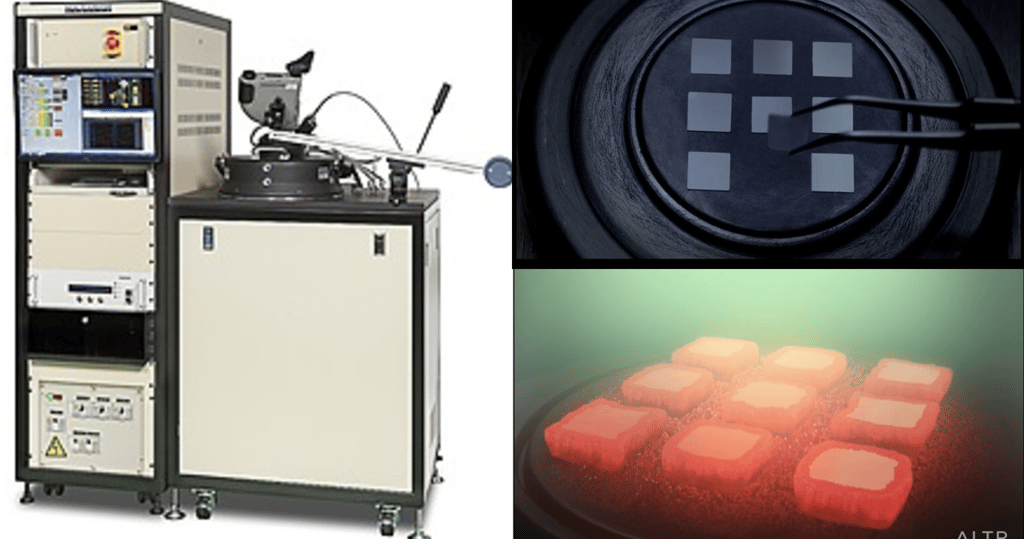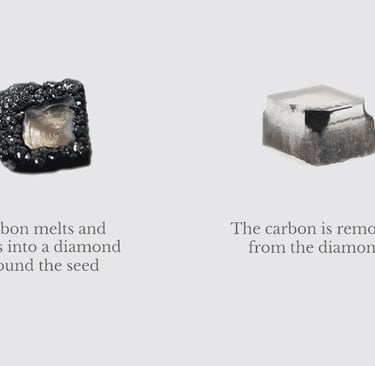Welcome to SHAMBH!
What Are CVD Diamonds? Full Guide
SHAMBH
11/7/20256 min read


The way we buy diamonds has changed forever. If you’ve heard of lab grown diamonds, you know they are real—but how exactly do scientists make them?
The secret lies in a method called CVD, or Chemical Vapor Deposition. This process isn't complicated magic; it's smart science that replicates nature in a clean, controlled environment. CVD diamonds are the result of this technology, giving you a beautiful, real diamond that matches the quality of stones found deep underground.
This definitive guide will explain, in simple terms, what CVD diamonds are, how the process works, why they are the preferred choice for ethical jewelry, and why understanding the CVD process is the key to getting spectacular value today.
The Basic Truth: A CVD Diamond is 100% Real
Let's clear up the biggest question first: A CVD diamond is a diamond. There is no chemical difference between a stone grown in a lab and one found in a mine. This fact is recognized by major gemological institutes worldwide.
Identical Composition, Identical Strength
The identity of a diamond rests on two non-negotiable facts: its chemistry and its strength.
Identical Composition: Both are made entirely of pure carbon (C) atoms arranged in the same crystal pattern. If you were to analyze the atoms of a CVD diamond and a mined diamond, you could not tell them apart.
Identical Strength: Both score a perfect 10 on the Mohs hardness scale . This means your CVD diamond is equally durable and strong enough for an affordable engagement ring or any piece of everyday diamonds. They resist scratching and chipping just as well as natural stones.
Not a Fake: CVD diamonds are not simulants (like cubic zirconia), which are entirely different materials. A standard diamond tester will confirm a CVD stone is a real diamond because its core properties are the same.
Purity: The Lab Advantage and Type IIa Status
One of the most compelling insights into lab-grown technology is the potential for purity. The controlled, pristine environment of the lab frequently allows the resulting diamond to achieve Type IIa status.
What is Type IIa? This is the purest form of diamond, historically representing less than 2% of natural diamonds. These stones contain virtually no nitrogen, leading to superior optical clarity and colorlessness.
Why Control Matters: This control helps ensure the stone has brilliant clarity and a clean, white color consistently, which is a major benefit over the variability found in nature.
How the CVD Process Works
The CVD process is a marvel of engineering that creates a diamond in weeks, not billions of years. It’s an efficient, controlled method that makes the science accessible and fascinating.
The technique relies on creating a unique environment where carbon atoms are forced to stack and bond onto an existing diamond template.
Start with a Seed (The Blueprint): The process begins with a tiny, flat slice of an existing diamond—the "seed." This is the atomic blueprint that guides the new growth.
Heat it Up (The Reactor): The seed is placed inside a sealed, high-temperature chamber. The temperature is crucial, maintaining the ideal conditions for chemical reaction without melting the diamond.
Add the Gas (The Raw Material): Carbon-containing gases, mainly methane (CH4), are carefully pumped into the chamber. This gas provides the pure carbon atoms needed to build the crystal.
Create the Plasma (The Energy Source): Microwave energy floods the chamber, heating the gases until they break apart and turn into a hot, energized cloud of plasma. This plasma separates the carbon atoms from the hydrogen.
Build the Crystal (Carbon Deposition): These pure carbon atoms settle onto the cooler diamond seed. They stack up perfectly, layer upon layer—a process called carbon deposition—until a rough diamond crystal has grown over a period of two to three weeks.
CVD vs. HPHT: Understanding the Two Paths
It's important to know that lab grown diamonds are also made using the HPHT method (High-Pressure/High-Temperature), which mimics the Earth's crushing force.
CVD is Different: CVD relies on chemical deposition at moderate pressures. This distinction means that even though both methods produce real diamonds, specialized gemological labs can identify which growth method was used by analyzing tiny, internal growth patterns.
Post-Growth Polishing: Ensuring Perfection
Occasionally, the rapid growth inherent in the CVD process can leave a faint, minor color tint. To ensure the final stone is perfectly colorless, many CVD diamonds undergo a brief, controlled heat treatment (often HPHT annealing). This simple, widely accepted process enhances the crystal's color stability, guaranteeing an optimal, white gem for your purchase.
Why Choose a CVD Diamond Today?
The choice of a CVD diamond is driven by core benefits that appeal directly to the modern buyer's values: price, honesty, and responsibility.
The manufacturing efficiency of the CVD process is the single greatest reason for its value compared to mined diamonds.
Financial Advantage: The lab diamond price is typically 60% to 85% lower than a mined diamond of the same size and quality. This isn't a reflection of quality; it's a reflection of lower overhead, shorter growth time, and a more direct supply chain.
Maximize Your Sparkle: This huge cost difference empowers you to buy a significantly larger stone. You can afford the superior Cut that creates spectacular light performance while still securing a larger Carat weight—the true essence of affordable luxury and a smart purchase.
Ethics, Responsibility, and Sustainable Jewelry
The origin story of CVD diamonds gives buyers complete peace of mind, aligning their purchase with their conscience.
Guaranteed Conflict-Free: Because the stone is grown in a certified lab, its origin is fully traceable. It is a guaranteed conflict-free diamond. This provides certainty and total ethical clarity, which is why CVD stones are the cornerstone of ethical jewelry.
The Sustainability Advantage: The CVD method requires minimal land and water, drastically reducing the physical footprint compared to mining. Furthermore, many manufacturers are now powering their CVD process facilities with renewable energy sources, making it a powerful statement for sustainable jewelry.
Assurance and Authenticity: Grading and Certification
All high-quality CVD diamonds are graded by the same independent experts who grade natural diamonds. This commitment to transparency ensures trust
Expert Scrutiny: Laboratories like IGI and GIA assess the stone using the universal 4Cs: Cut, Color, Clarity, and Carat.
Transparent Report: The certified lab diamond report explicitly notes the stone's origin as "Laboratory Grown" and confirms the CVD growth method. This provides the buyer with total, undeniable assurance regarding the stone's quality and history.
FAQs About CVD Diamonds
To provide absolute clarity and address common consumer queries quickly and directly, here are the facts on CVD technology:
Do CVD diamonds last forever?
Yes. Since a CVD diamond is chemically and physically identical to a natural diamond, it is equally durable (Mohs 10) and will last forever without clouding, fading, or changing color.
Can a jeweler tell the difference?
No, not without specialized equipment. A jeweler cannot distinguish a CVD diamond from a mined diamond using standard magnification tools because their outward appearance and structure are identical. Only advanced spectroscopic tools used by grading labs can identify the growth method.
Is a CVD diamond better than HPHT?
Neither method is inherently "better." Both the CVD and HPHT processes create real diamonds. The choice is often determined by the desired size and color output, but both are certified and graded equally by laboratories.
Are colored diamonds available through the CVD process?
Yes. Scientists can introduce trace elements (like nitrogen or boron) during the CVD process to create stunning, vibrant fancy-colored diamonds (such as yellows and pinks). This makes rare colored diamonds more accessible.
What are the 4Cs of a CVD Diamond?
The 4Cs stand for Cut, Color, Clarity, and Carat. These are the universal standards used by organizations like GIA and IGI to grade the quality of all diamonds, regardless of whether they are lab grown or natural.
SHAMBH Assurance: Your Direct Link to Expertise and Value
This dedication to quality and transparency is the foundation of the SHAMBH promise.
SHAMBH is more than just a diamond supplier; we are expert wholesalers of loose diamonds and master manufacturers, controlling the entire supply chain of the stone. This direct involvement eliminates unnecessary market layers, guaranteeing the highest quality and transparent value for all our clients and partners. We handle everything from sourcing the perfect certified lab diamond to realizing intricate designs through our advanced manufacturing capabilities.
We invite you to partner with a source that embodies both technical excellence and transparent value, securing your purchase with the confidence that only a direct manufacturer can provide.
Contact SHAMBH: Your Source for Certified, Custom Diamond Jewelry


Elegance
Discover our exquisite diamond jewelry collections today.
Get in Touch
Subscribe
support@shambh.com
+91 96012 68918
© Shambh 2025. All rights reserved.
